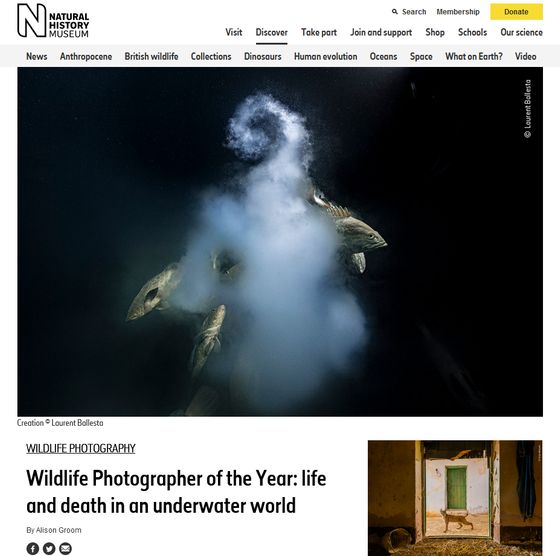Photograph of 'Grizzly bear just before attacking the camera' won a prize in the photo contest of the Natural History Museum in London

Grizzly leftovers | Wildlife Photographer of the Year | Natural History Museum
https://www.nhm.ac.uk/wpy/gallery/2021-grizzly-leftovers
Hungry grizzly bear photo-bombs camera trap in award-winning photo | Live Science
https://www.livescience.com/grizzly-bear-attacks-camera
The Wildlife Photographer Award is a historic award that will celebrate its 57th anniversary in 2021, and in 2021 there were 50,000 entries from all over the world, including professionals and amateurs. 100 of all entries will be exhibited at the Natural History Museum in London as prize-winning works, and general admission will be accepted from October 15, 2021.
Among the 2021 prize-winning works, a photograph called 'Grizzly leftovers ' taken by photographer Zack Clothier, who is based in Montana, USA, was selected.
The picture below is 'Grizzly leftovers'. In the center of the photo taken near the ground, you can see the dead elk with only bones and fur, and in the upper right corner of the screen you can see the powerful face of a grizzly bear looking into the camera. In addition, scary claws are also reflected under the face, and you can feel the threat of the wild. You can see a larger size photo by clicking the photo.

by Zack Clothier
Clothier said he found a dead elk in the woods near his home in the winter of 2019-2020. And, hoping to be able to shoot wild animals gathering in the carcass, he put a camera equipped with an infrared sensor that detects the movement of the animal and releases the shutter in the case, set it on a tripod and left it for 2 months. ..
Clothier, who tried to retrieve the camera in the spring, noticed bear footprints on the road leading to the elk carcass. When I checked another camera installed to monitor the road in the forest, I heard that a male grizzly bear was walking on the road leading to the corpse just that morning. 'I stayed there for a while and made a noise to drive away anything that might be near the carcass, especially the bear,' said Clothier.
And when Mr. Clothier carefully headed to the bottom of the camera, there was a camera case that was squeezed at the base of the tree and a tripod that was separated from the camera body and was abandoned. The camera case had scratches on the grizzly bear's claws, but fortunately I was able to retrieve the photo from the camera body, which contained the figure of the grizzly bear just before it attacked the camera.
The grizzly bear may try to protect the corpse he found, and the shutter sound of the camera that detected the movement and took the picture surprised the grizzly bear, so it is possible that he attacked the camera. “I really like this photo. It's definitely unique,” said Clothier.
The winner of the Wildlife Photographer Award was a photograph called 'Creation' taken by French photographer Laurent Ballesta. This is a picture of sperm and eggs released by Madarahata swirling like a cloud in the waters of Fakarava Atoll in French Polynesia.
Wildlife Photographer of the Year: life and death in an underwater world | Natural History Museum
https://www.nhm.ac.uk/discover/wildlife-photographer-of-the-year-life-and-death-underwater.html

The Natural History Museum in London is accepting entries from around the world for the 2022 Wildlife Photographers Awards from October 18th to December 9th, 2021.
Enter the competition | Wildlife Photographer of the Year | Natural History Museum
https://www.nhm.ac.uk/wpy/competition/enter-the-competition
Related Posts:
in Creature, Posted by log1h_ik







